Data Analytics Terminologies Report: Key Concepts and Analysis
VerifiedAdded on 2021/02/19
|13
|3910
|27
Report
AI Summary
This report provides a comprehensive overview of data analytics, starting with essential terminologies like population, sample, and various data types (categorical, ordinal, nominal, continuous, and discrete). It then delves into critical evaluations of data analytic methods, differentiating between descriptive, predictive, and prescriptive analytics. The report emphasizes the importance of data analytics for businesses, particularly through the lens of Exploratory Data Analysis (EDA) and its graphical and non-graphical methods. Furthermore, it evaluates analytical model data preparation processes, detailing stages such as data collection, cleaning, and summarization. The report concludes by assessing methods for visualizing analytical model outputs and highlights how programming languages or tools demonstrate descriptive, predictive, and prescriptive analytic techniques contribute to decision-making and forecasting. The report also covers issues related to data preparation, visualization, and assumptions regarding sampling and statistical inferences.

DATA ANALYTICS
TERMINOLOGIES
TERMINOLOGIES
Paraphrase This Document
Need a fresh take? Get an instant paraphrase of this document with our AI Paraphraser
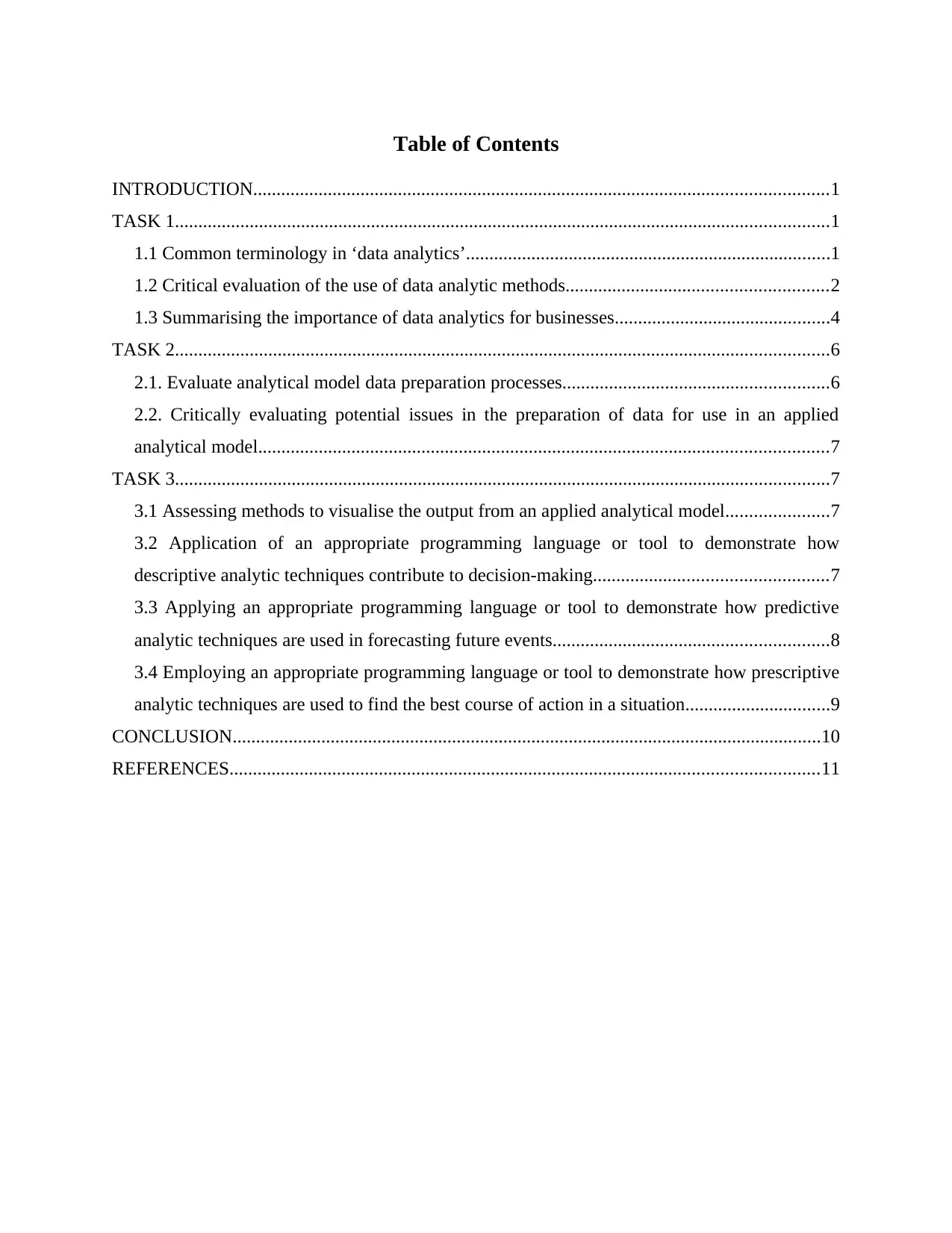
Table of Contents
INTRODUCTION...........................................................................................................................1
TASK 1............................................................................................................................................1
1.1 Common terminology in ‘data analytics’..............................................................................1
1.2 Critical evaluation of the use of data analytic methods........................................................2
1.3 Summarising the importance of data analytics for businesses..............................................4
TASK 2............................................................................................................................................6
2.1. Evaluate analytical model data preparation processes.........................................................6
2.2. Critically evaluating potential issues in the preparation of data for use in an applied
analytical model..........................................................................................................................7
TASK 3............................................................................................................................................7
3.1 Assessing methods to visualise the output from an applied analytical model......................7
3.2 Application of an appropriate programming language or tool to demonstrate how
descriptive analytic techniques contribute to decision-making..................................................7
3.3 Applying an appropriate programming language or tool to demonstrate how predictive
analytic techniques are used in forecasting future events...........................................................8
3.4 Employing an appropriate programming language or tool to demonstrate how prescriptive
analytic techniques are used to find the best course of action in a situation...............................9
CONCLUSION..............................................................................................................................10
REFERENCES..............................................................................................................................11
INTRODUCTION...........................................................................................................................1
TASK 1............................................................................................................................................1
1.1 Common terminology in ‘data analytics’..............................................................................1
1.2 Critical evaluation of the use of data analytic methods........................................................2
1.3 Summarising the importance of data analytics for businesses..............................................4
TASK 2............................................................................................................................................6
2.1. Evaluate analytical model data preparation processes.........................................................6
2.2. Critically evaluating potential issues in the preparation of data for use in an applied
analytical model..........................................................................................................................7
TASK 3............................................................................................................................................7
3.1 Assessing methods to visualise the output from an applied analytical model......................7
3.2 Application of an appropriate programming language or tool to demonstrate how
descriptive analytic techniques contribute to decision-making..................................................7
3.3 Applying an appropriate programming language or tool to demonstrate how predictive
analytic techniques are used in forecasting future events...........................................................8
3.4 Employing an appropriate programming language or tool to demonstrate how prescriptive
analytic techniques are used to find the best course of action in a situation...............................9
CONCLUSION..............................................................................................................................10
REFERENCES..............................................................................................................................11

INTRODUCTION
In present-day scenario, the utilisation of machines and technologies have gained
prominence so much so that the organisations have become heavily reliant on its mechanisms for
deriving valuable insights in order to maximise their goals (Andrejevic and Gates, 2014). At its
core, this field is established on the principles of statistics which cater to the needs of
government and organisations alike. Data Analysis is crucial for the organisations as it facilitates
prompt and hassle-free solutions to a given set of challenges that arise either on a day-to-day
basis or occasionally. Today, this area has evolved in the form of Artificial or Business
Intelligence as well as Machine Learning thaty is helping companies worldwide to fulfil client
needs in a significant manner.
The following report aims to provide a detailed account on the terminology used in the
field of Data Analytics. Additionally, the given project report also includes various analysis such
as Exploratory, Predictive and Descriptive along with their application by way of employing a
certain programming language or tool. Also, various issues related to data preparation,
visualisation as well as assumptions regarding sampling and statistical inferences have been
discussed in detail.
TASK 1
1.1 Common terminology in ‘data analytics’
Essentially, the concept of 'data analytics' can be defined as a process of collecting and
examining a large pool of information so as to uncover hidden patterns which enable the
business enterprises to gain valuable insights regarding organisational operations. Through this,
the business manager is able to draw valuable inferences and gain insights in relation to a
particular problem or situation. Since its a broad term, this area of analytics is constituent of wide
array of elements. These have been explained as under:
Population:
A pool of information which includes specific sets of variables that have similar characteristics
from which a statistical sample is drawn for the purpose of analysing and gaining insights
regarding a particular hypothesis (Chen, Chiang and Storey, 2012).
Sample:
1
In present-day scenario, the utilisation of machines and technologies have gained
prominence so much so that the organisations have become heavily reliant on its mechanisms for
deriving valuable insights in order to maximise their goals (Andrejevic and Gates, 2014). At its
core, this field is established on the principles of statistics which cater to the needs of
government and organisations alike. Data Analysis is crucial for the organisations as it facilitates
prompt and hassle-free solutions to a given set of challenges that arise either on a day-to-day
basis or occasionally. Today, this area has evolved in the form of Artificial or Business
Intelligence as well as Machine Learning thaty is helping companies worldwide to fulfil client
needs in a significant manner.
The following report aims to provide a detailed account on the terminology used in the
field of Data Analytics. Additionally, the given project report also includes various analysis such
as Exploratory, Predictive and Descriptive along with their application by way of employing a
certain programming language or tool. Also, various issues related to data preparation,
visualisation as well as assumptions regarding sampling and statistical inferences have been
discussed in detail.
TASK 1
1.1 Common terminology in ‘data analytics’
Essentially, the concept of 'data analytics' can be defined as a process of collecting and
examining a large pool of information so as to uncover hidden patterns which enable the
business enterprises to gain valuable insights regarding organisational operations. Through this,
the business manager is able to draw valuable inferences and gain insights in relation to a
particular problem or situation. Since its a broad term, this area of analytics is constituent of wide
array of elements. These have been explained as under:
Population:
A pool of information which includes specific sets of variables that have similar characteristics
from which a statistical sample is drawn for the purpose of analysing and gaining insights
regarding a particular hypothesis (Chen, Chiang and Storey, 2012).
Sample:
1
⊘ This is a preview!⊘
Do you want full access?
Subscribe today to unlock all pages.

Trusted by 1+ million students worldwide
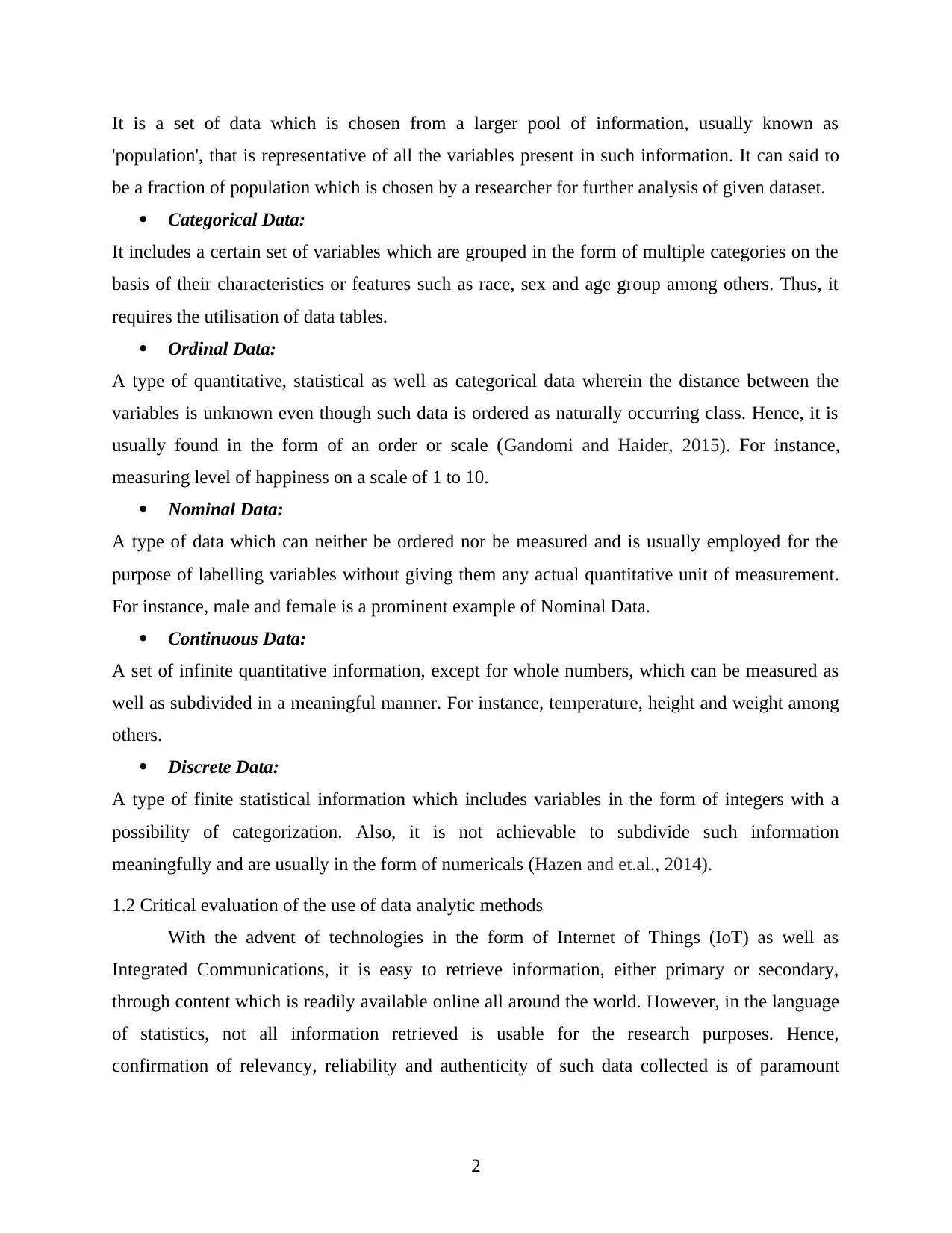
It is a set of data which is chosen from a larger pool of information, usually known as
'population', that is representative of all the variables present in such information. It can said to
be a fraction of population which is chosen by a researcher for further analysis of given dataset.
Categorical Data:
It includes a certain set of variables which are grouped in the form of multiple categories on the
basis of their characteristics or features such as race, sex and age group among others. Thus, it
requires the utilisation of data tables.
Ordinal Data:
A type of quantitative, statistical as well as categorical data wherein the distance between the
variables is unknown even though such data is ordered as naturally occurring class. Hence, it is
usually found in the form of an order or scale (Gandomi and Haider, 2015). For instance,
measuring level of happiness on a scale of 1 to 10.
Nominal Data:
A type of data which can neither be ordered nor be measured and is usually employed for the
purpose of labelling variables without giving them any actual quantitative unit of measurement.
For instance, male and female is a prominent example of Nominal Data.
Continuous Data:
A set of infinite quantitative information, except for whole numbers, which can be measured as
well as subdivided in a meaningful manner. For instance, temperature, height and weight among
others.
Discrete Data:
A type of finite statistical information which includes variables in the form of integers with a
possibility of categorization. Also, it is not achievable to subdivide such information
meaningfully and are usually in the form of numericals (Hazen and et.al., 2014).
1.2 Critical evaluation of the use of data analytic methods
With the advent of technologies in the form of Internet of Things (IoT) as well as
Integrated Communications, it is easy to retrieve information, either primary or secondary,
through content which is readily available online all around the world. However, in the language
of statistics, not all information retrieved is usable for the research purposes. Hence,
confirmation of relevancy, reliability and authenticity of such data collected is of paramount
2
'population', that is representative of all the variables present in such information. It can said to
be a fraction of population which is chosen by a researcher for further analysis of given dataset.
Categorical Data:
It includes a certain set of variables which are grouped in the form of multiple categories on the
basis of their characteristics or features such as race, sex and age group among others. Thus, it
requires the utilisation of data tables.
Ordinal Data:
A type of quantitative, statistical as well as categorical data wherein the distance between the
variables is unknown even though such data is ordered as naturally occurring class. Hence, it is
usually found in the form of an order or scale (Gandomi and Haider, 2015). For instance,
measuring level of happiness on a scale of 1 to 10.
Nominal Data:
A type of data which can neither be ordered nor be measured and is usually employed for the
purpose of labelling variables without giving them any actual quantitative unit of measurement.
For instance, male and female is a prominent example of Nominal Data.
Continuous Data:
A set of infinite quantitative information, except for whole numbers, which can be measured as
well as subdivided in a meaningful manner. For instance, temperature, height and weight among
others.
Discrete Data:
A type of finite statistical information which includes variables in the form of integers with a
possibility of categorization. Also, it is not achievable to subdivide such information
meaningfully and are usually in the form of numericals (Hazen and et.al., 2014).
1.2 Critical evaluation of the use of data analytic methods
With the advent of technologies in the form of Internet of Things (IoT) as well as
Integrated Communications, it is easy to retrieve information, either primary or secondary,
through content which is readily available online all around the world. However, in the language
of statistics, not all information retrieved is usable for the research purposes. Hence,
confirmation of relevancy, reliability and authenticity of such data collected is of paramount
2
Paraphrase This Document
Need a fresh take? Get an instant paraphrase of this document with our AI Paraphraser
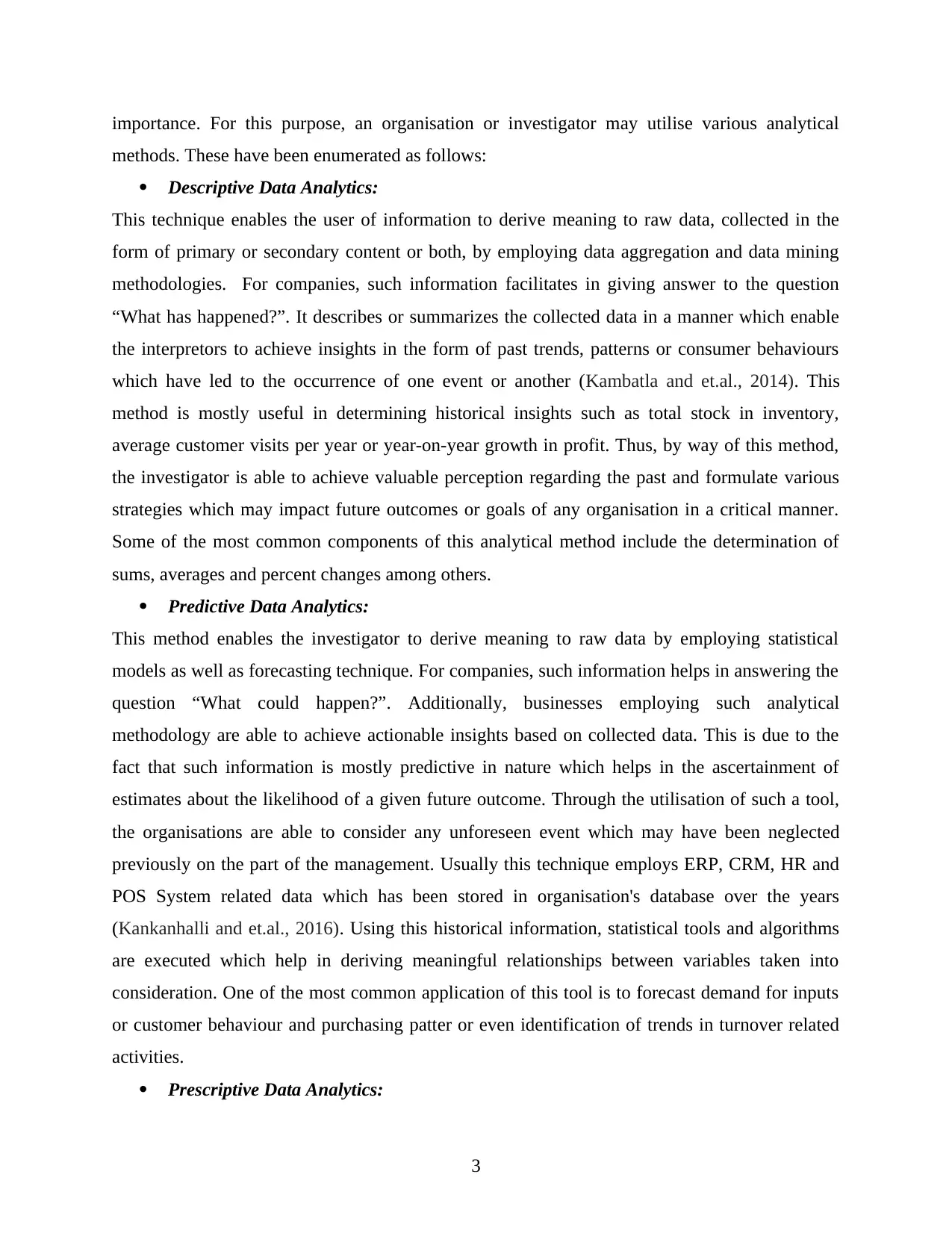
importance. For this purpose, an organisation or investigator may utilise various analytical
methods. These have been enumerated as follows:
Descriptive Data Analytics:
This technique enables the user of information to derive meaning to raw data, collected in the
form of primary or secondary content or both, by employing data aggregation and data mining
methodologies. For companies, such information facilitates in giving answer to the question
“What has happened?”. It describes or summarizes the collected data in a manner which enable
the interpretors to achieve insights in the form of past trends, patterns or consumer behaviours
which have led to the occurrence of one event or another (Kambatla and et.al., 2014). This
method is mostly useful in determining historical insights such as total stock in inventory,
average customer visits per year or year-on-year growth in profit. Thus, by way of this method,
the investigator is able to achieve valuable perception regarding the past and formulate various
strategies which may impact future outcomes or goals of any organisation in a critical manner.
Some of the most common components of this analytical method include the determination of
sums, averages and percent changes among others.
Predictive Data Analytics:
This method enables the investigator to derive meaning to raw data by employing statistical
models as well as forecasting technique. For companies, such information helps in answering the
question “What could happen?”. Additionally, businesses employing such analytical
methodology are able to achieve actionable insights based on collected data. This is due to the
fact that such information is mostly predictive in nature which helps in the ascertainment of
estimates about the likelihood of a given future outcome. Through the utilisation of such a tool,
the organisations are able to consider any unforeseen event which may have been neglected
previously on the part of the management. Usually this technique employs ERP, CRM, HR and
POS System related data which has been stored in organisation's database over the years
(Kankanhalli and et.al., 2016). Using this historical information, statistical tools and algorithms
are executed which help in deriving meaningful relationships between variables taken into
consideration. One of the most common application of this tool is to forecast demand for inputs
or customer behaviour and purchasing patter or even identification of trends in turnover related
activities.
Prescriptive Data Analytics:
3
methods. These have been enumerated as follows:
Descriptive Data Analytics:
This technique enables the user of information to derive meaning to raw data, collected in the
form of primary or secondary content or both, by employing data aggregation and data mining
methodologies. For companies, such information facilitates in giving answer to the question
“What has happened?”. It describes or summarizes the collected data in a manner which enable
the interpretors to achieve insights in the form of past trends, patterns or consumer behaviours
which have led to the occurrence of one event or another (Kambatla and et.al., 2014). This
method is mostly useful in determining historical insights such as total stock in inventory,
average customer visits per year or year-on-year growth in profit. Thus, by way of this method,
the investigator is able to achieve valuable perception regarding the past and formulate various
strategies which may impact future outcomes or goals of any organisation in a critical manner.
Some of the most common components of this analytical method include the determination of
sums, averages and percent changes among others.
Predictive Data Analytics:
This method enables the investigator to derive meaning to raw data by employing statistical
models as well as forecasting technique. For companies, such information helps in answering the
question “What could happen?”. Additionally, businesses employing such analytical
methodology are able to achieve actionable insights based on collected data. This is due to the
fact that such information is mostly predictive in nature which helps in the ascertainment of
estimates about the likelihood of a given future outcome. Through the utilisation of such a tool,
the organisations are able to consider any unforeseen event which may have been neglected
previously on the part of the management. Usually this technique employs ERP, CRM, HR and
POS System related data which has been stored in organisation's database over the years
(Kankanhalli and et.al., 2016). Using this historical information, statistical tools and algorithms
are executed which help in deriving meaningful relationships between variables taken into
consideration. One of the most common application of this tool is to forecast demand for inputs
or customer behaviour and purchasing patter or even identification of trends in turnover related
activities.
Prescriptive Data Analytics:
3
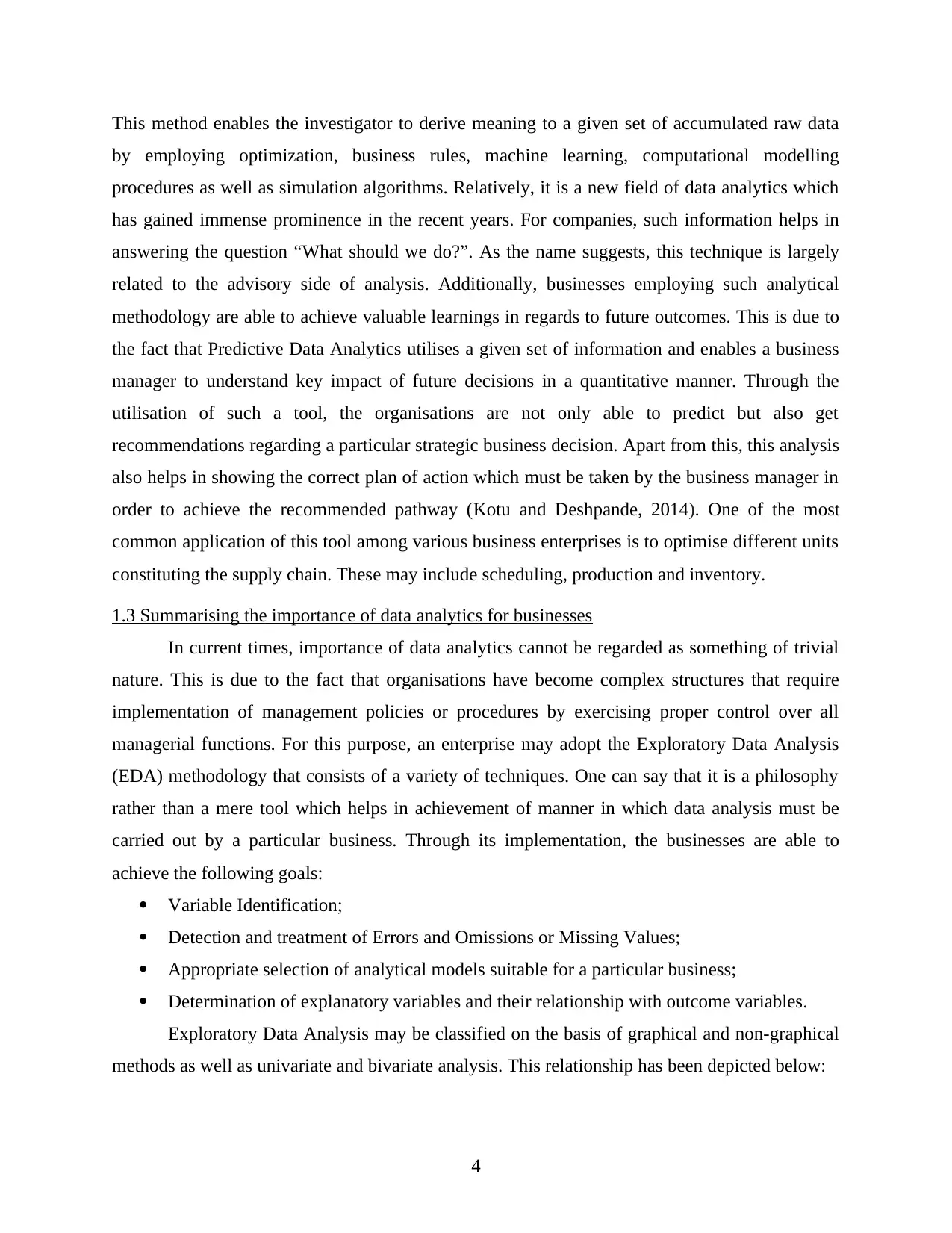
This method enables the investigator to derive meaning to a given set of accumulated raw data
by employing optimization, business rules, machine learning, computational modelling
procedures as well as simulation algorithms. Relatively, it is a new field of data analytics which
has gained immense prominence in the recent years. For companies, such information helps in
answering the question “What should we do?”. As the name suggests, this technique is largely
related to the advisory side of analysis. Additionally, businesses employing such analytical
methodology are able to achieve valuable learnings in regards to future outcomes. This is due to
the fact that Predictive Data Analytics utilises a given set of information and enables a business
manager to understand key impact of future decisions in a quantitative manner. Through the
utilisation of such a tool, the organisations are not only able to predict but also get
recommendations regarding a particular strategic business decision. Apart from this, this analysis
also helps in showing the correct plan of action which must be taken by the business manager in
order to achieve the recommended pathway (Kotu and Deshpande, 2014). One of the most
common application of this tool among various business enterprises is to optimise different units
constituting the supply chain. These may include scheduling, production and inventory.
1.3 Summarising the importance of data analytics for businesses
In current times, importance of data analytics cannot be regarded as something of trivial
nature. This is due to the fact that organisations have become complex structures that require
implementation of management policies or procedures by exercising proper control over all
managerial functions. For this purpose, an enterprise may adopt the Exploratory Data Analysis
(EDA) methodology that consists of a variety of techniques. One can say that it is a philosophy
rather than a mere tool which helps in achievement of manner in which data analysis must be
carried out by a particular business. Through its implementation, the businesses are able to
achieve the following goals:
Variable Identification;
Detection and treatment of Errors and Omissions or Missing Values;
Appropriate selection of analytical models suitable for a particular business;
Determination of explanatory variables and their relationship with outcome variables.
Exploratory Data Analysis may be classified on the basis of graphical and non-graphical
methods as well as univariate and bivariate analysis. This relationship has been depicted below:
4
by employing optimization, business rules, machine learning, computational modelling
procedures as well as simulation algorithms. Relatively, it is a new field of data analytics which
has gained immense prominence in the recent years. For companies, such information helps in
answering the question “What should we do?”. As the name suggests, this technique is largely
related to the advisory side of analysis. Additionally, businesses employing such analytical
methodology are able to achieve valuable learnings in regards to future outcomes. This is due to
the fact that Predictive Data Analytics utilises a given set of information and enables a business
manager to understand key impact of future decisions in a quantitative manner. Through the
utilisation of such a tool, the organisations are not only able to predict but also get
recommendations regarding a particular strategic business decision. Apart from this, this analysis
also helps in showing the correct plan of action which must be taken by the business manager in
order to achieve the recommended pathway (Kotu and Deshpande, 2014). One of the most
common application of this tool among various business enterprises is to optimise different units
constituting the supply chain. These may include scheduling, production and inventory.
1.3 Summarising the importance of data analytics for businesses
In current times, importance of data analytics cannot be regarded as something of trivial
nature. This is due to the fact that organisations have become complex structures that require
implementation of management policies or procedures by exercising proper control over all
managerial functions. For this purpose, an enterprise may adopt the Exploratory Data Analysis
(EDA) methodology that consists of a variety of techniques. One can say that it is a philosophy
rather than a mere tool which helps in achievement of manner in which data analysis must be
carried out by a particular business. Through its implementation, the businesses are able to
achieve the following goals:
Variable Identification;
Detection and treatment of Errors and Omissions or Missing Values;
Appropriate selection of analytical models suitable for a particular business;
Determination of explanatory variables and their relationship with outcome variables.
Exploratory Data Analysis may be classified on the basis of graphical and non-graphical
methods as well as univariate and bivariate analysis. This relationship has been depicted below:
4
⊘ This is a preview!⊘
Do you want full access?
Subscribe today to unlock all pages.

Trusted by 1+ million students worldwide

Ill
ustration 1: Types of EDA
(Source: Types of EDA, 2019)
The Graphical Methods employ the summarisation of data in a diagrammatic manner
whereas under Non-Graphical the data is presented in the form of summary statistics
(Manoochehri, 2013). On the other hand, Univariate Analysis includes scrutinizing a single
variable at a time and vice versa. It is usually recommended to execute a Univariate EDA
Analysis before performing a Bi-variate or Multi-variate investigation for a given set of
variables.
In a nutshell, one can state that Exploratory Data Analysis helps in simplifying the
presentation of numeric information in an attractive and easily communicative manner. This is
mainly due to the fact that managers does not have time for looking at each and every variable or
table. Through the implementation of EDA, in the context of current business scenario,
organisations have been able to achieve faster and reliable communication of important
5
ustration 1: Types of EDA
(Source: Types of EDA, 2019)
The Graphical Methods employ the summarisation of data in a diagrammatic manner
whereas under Non-Graphical the data is presented in the form of summary statistics
(Manoochehri, 2013). On the other hand, Univariate Analysis includes scrutinizing a single
variable at a time and vice versa. It is usually recommended to execute a Univariate EDA
Analysis before performing a Bi-variate or Multi-variate investigation for a given set of
variables.
In a nutshell, one can state that Exploratory Data Analysis helps in simplifying the
presentation of numeric information in an attractive and easily communicative manner. This is
mainly due to the fact that managers does not have time for looking at each and every variable or
table. Through the implementation of EDA, in the context of current business scenario,
organisations have been able to achieve faster and reliable communication of important
5
Paraphrase This Document
Need a fresh take? Get an instant paraphrase of this document with our AI Paraphraser
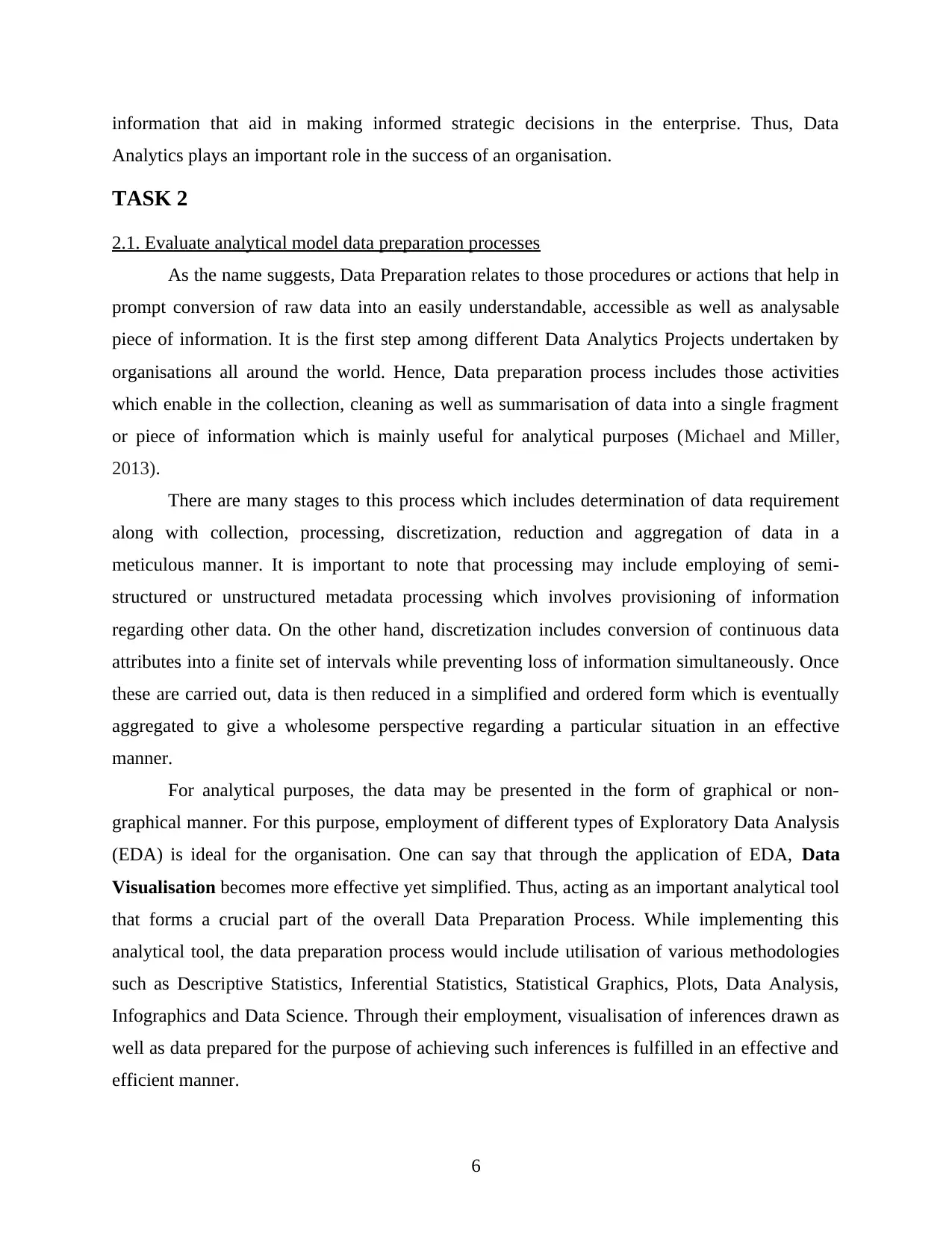
information that aid in making informed strategic decisions in the enterprise. Thus, Data
Analytics plays an important role in the success of an organisation.
TASK 2
2.1. Evaluate analytical model data preparation processes
As the name suggests, Data Preparation relates to those procedures or actions that help in
prompt conversion of raw data into an easily understandable, accessible as well as analysable
piece of information. It is the first step among different Data Analytics Projects undertaken by
organisations all around the world. Hence, Data preparation process includes those activities
which enable in the collection, cleaning as well as summarisation of data into a single fragment
or piece of information which is mainly useful for analytical purposes (Michael and Miller,
2013).
There are many stages to this process which includes determination of data requirement
along with collection, processing, discretization, reduction and aggregation of data in a
meticulous manner. It is important to note that processing may include employing of semi-
structured or unstructured metadata processing which involves provisioning of information
regarding other data. On the other hand, discretization includes conversion of continuous data
attributes into a finite set of intervals while preventing loss of information simultaneously. Once
these are carried out, data is then reduced in a simplified and ordered form which is eventually
aggregated to give a wholesome perspective regarding a particular situation in an effective
manner.
For analytical purposes, the data may be presented in the form of graphical or non-
graphical manner. For this purpose, employment of different types of Exploratory Data Analysis
(EDA) is ideal for the organisation. One can say that through the application of EDA, Data
Visualisation becomes more effective yet simplified. Thus, acting as an important analytical tool
that forms a crucial part of the overall Data Preparation Process. While implementing this
analytical tool, the data preparation process would include utilisation of various methodologies
such as Descriptive Statistics, Inferential Statistics, Statistical Graphics, Plots, Data Analysis,
Infographics and Data Science. Through their employment, visualisation of inferences drawn as
well as data prepared for the purpose of achieving such inferences is fulfilled in an effective and
efficient manner.
6
Analytics plays an important role in the success of an organisation.
TASK 2
2.1. Evaluate analytical model data preparation processes
As the name suggests, Data Preparation relates to those procedures or actions that help in
prompt conversion of raw data into an easily understandable, accessible as well as analysable
piece of information. It is the first step among different Data Analytics Projects undertaken by
organisations all around the world. Hence, Data preparation process includes those activities
which enable in the collection, cleaning as well as summarisation of data into a single fragment
or piece of information which is mainly useful for analytical purposes (Michael and Miller,
2013).
There are many stages to this process which includes determination of data requirement
along with collection, processing, discretization, reduction and aggregation of data in a
meticulous manner. It is important to note that processing may include employing of semi-
structured or unstructured metadata processing which involves provisioning of information
regarding other data. On the other hand, discretization includes conversion of continuous data
attributes into a finite set of intervals while preventing loss of information simultaneously. Once
these are carried out, data is then reduced in a simplified and ordered form which is eventually
aggregated to give a wholesome perspective regarding a particular situation in an effective
manner.
For analytical purposes, the data may be presented in the form of graphical or non-
graphical manner. For this purpose, employment of different types of Exploratory Data Analysis
(EDA) is ideal for the organisation. One can say that through the application of EDA, Data
Visualisation becomes more effective yet simplified. Thus, acting as an important analytical tool
that forms a crucial part of the overall Data Preparation Process. While implementing this
analytical tool, the data preparation process would include utilisation of various methodologies
such as Descriptive Statistics, Inferential Statistics, Statistical Graphics, Plots, Data Analysis,
Infographics and Data Science. Through their employment, visualisation of inferences drawn as
well as data prepared for the purpose of achieving such inferences is fulfilled in an effective and
efficient manner.
6
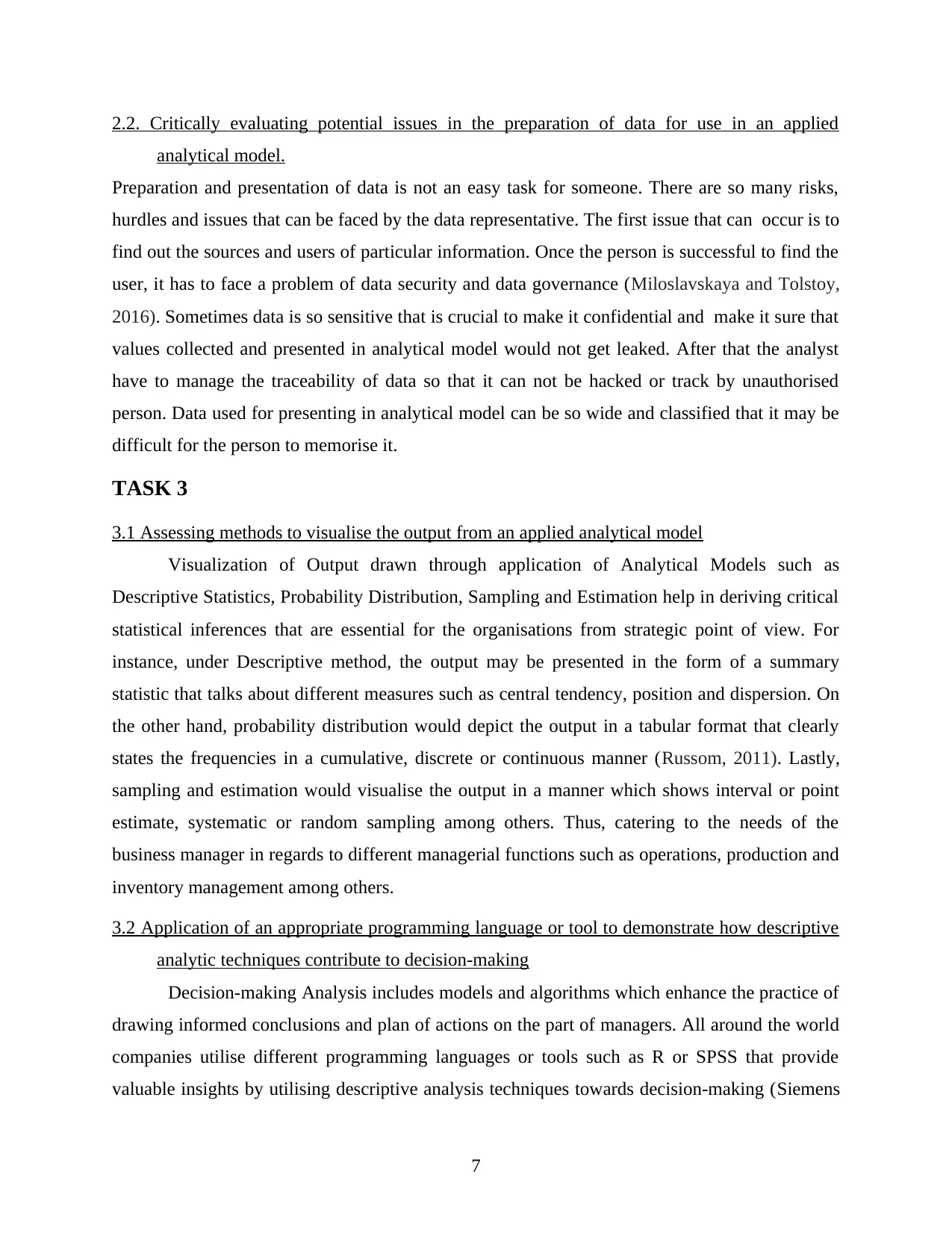
2.2. Critically evaluating potential issues in the preparation of data for use in an applied
analytical model.
Preparation and presentation of data is not an easy task for someone. There are so many risks,
hurdles and issues that can be faced by the data representative. The first issue that can occur is to
find out the sources and users of particular information. Once the person is successful to find the
user, it has to face a problem of data security and data governance (Miloslavskaya and Tolstoy,
2016). Sometimes data is so sensitive that is crucial to make it confidential and make it sure that
values collected and presented in analytical model would not get leaked. After that the analyst
have to manage the traceability of data so that it can not be hacked or track by unauthorised
person. Data used for presenting in analytical model can be so wide and classified that it may be
difficult for the person to memorise it.
TASK 3
3.1 Assessing methods to visualise the output from an applied analytical model
Visualization of Output drawn through application of Analytical Models such as
Descriptive Statistics, Probability Distribution, Sampling and Estimation help in deriving critical
statistical inferences that are essential for the organisations from strategic point of view. For
instance, under Descriptive method, the output may be presented in the form of a summary
statistic that talks about different measures such as central tendency, position and dispersion. On
the other hand, probability distribution would depict the output in a tabular format that clearly
states the frequencies in a cumulative, discrete or continuous manner (Russom, 2011). Lastly,
sampling and estimation would visualise the output in a manner which shows interval or point
estimate, systematic or random sampling among others. Thus, catering to the needs of the
business manager in regards to different managerial functions such as operations, production and
inventory management among others.
3.2 Application of an appropriate programming language or tool to demonstrate how descriptive
analytic techniques contribute to decision-making
Decision-making Analysis includes models and algorithms which enhance the practice of
drawing informed conclusions and plan of actions on the part of managers. All around the world
companies utilise different programming languages or tools such as R or SPSS that provide
valuable insights by utilising descriptive analysis techniques towards decision-making (Siemens
7
analytical model.
Preparation and presentation of data is not an easy task for someone. There are so many risks,
hurdles and issues that can be faced by the data representative. The first issue that can occur is to
find out the sources and users of particular information. Once the person is successful to find the
user, it has to face a problem of data security and data governance (Miloslavskaya and Tolstoy,
2016). Sometimes data is so sensitive that is crucial to make it confidential and make it sure that
values collected and presented in analytical model would not get leaked. After that the analyst
have to manage the traceability of data so that it can not be hacked or track by unauthorised
person. Data used for presenting in analytical model can be so wide and classified that it may be
difficult for the person to memorise it.
TASK 3
3.1 Assessing methods to visualise the output from an applied analytical model
Visualization of Output drawn through application of Analytical Models such as
Descriptive Statistics, Probability Distribution, Sampling and Estimation help in deriving critical
statistical inferences that are essential for the organisations from strategic point of view. For
instance, under Descriptive method, the output may be presented in the form of a summary
statistic that talks about different measures such as central tendency, position and dispersion. On
the other hand, probability distribution would depict the output in a tabular format that clearly
states the frequencies in a cumulative, discrete or continuous manner (Russom, 2011). Lastly,
sampling and estimation would visualise the output in a manner which shows interval or point
estimate, systematic or random sampling among others. Thus, catering to the needs of the
business manager in regards to different managerial functions such as operations, production and
inventory management among others.
3.2 Application of an appropriate programming language or tool to demonstrate how descriptive
analytic techniques contribute to decision-making
Decision-making Analysis includes models and algorithms which enhance the practice of
drawing informed conclusions and plan of actions on the part of managers. All around the world
companies utilise different programming languages or tools such as R or SPSS that provide
valuable insights by utilising descriptive analysis techniques towards decision-making (Siemens
7
⊘ This is a preview!⊘
Do you want full access?
Subscribe today to unlock all pages.

Trusted by 1+ million students worldwide
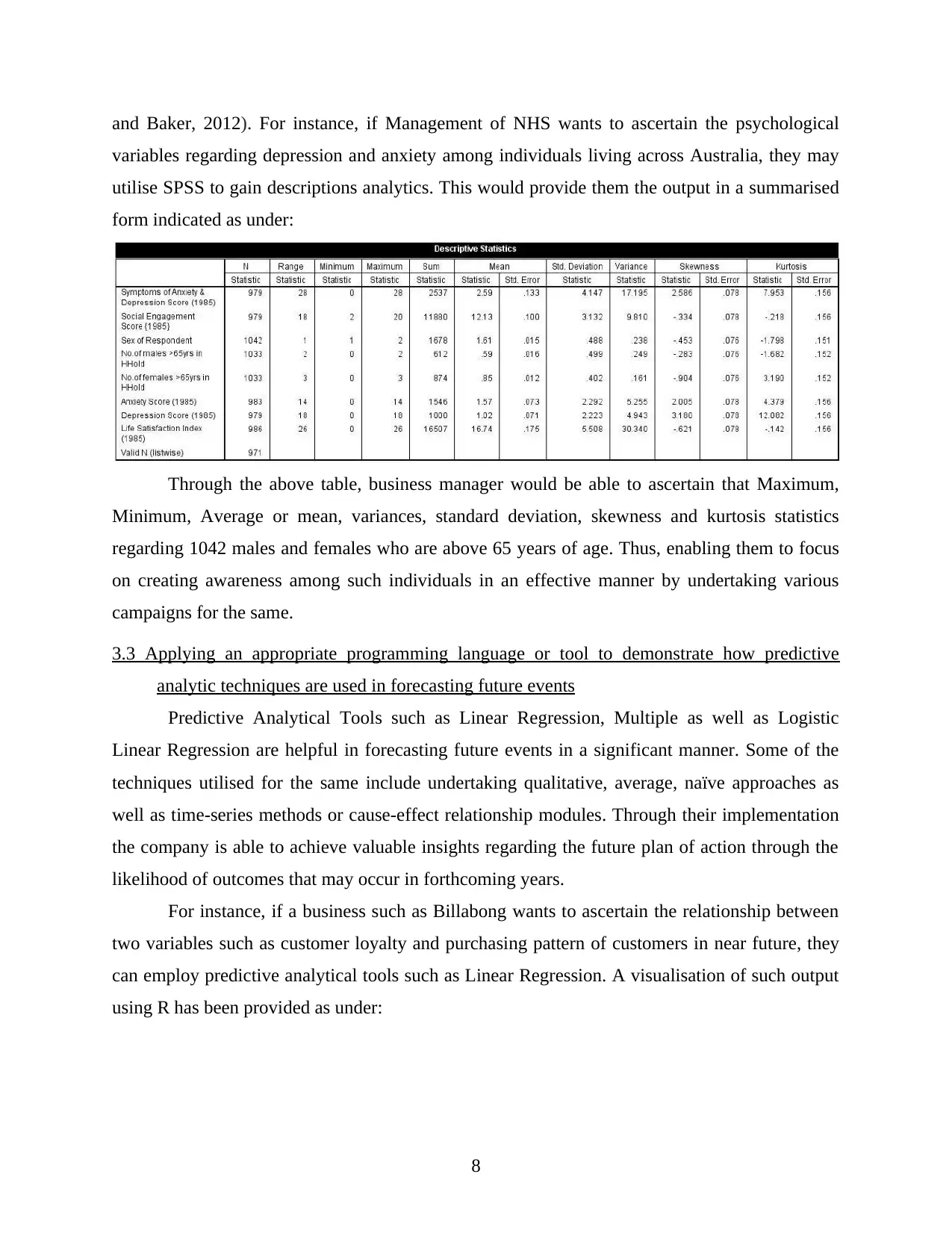
and Baker, 2012). For instance, if Management of NHS wants to ascertain the psychological
variables regarding depression and anxiety among individuals living across Australia, they may
utilise SPSS to gain descriptions analytics. This would provide them the output in a summarised
form indicated as under:
Through the above table, business manager would be able to ascertain that Maximum,
Minimum, Average or mean, variances, standard deviation, skewness and kurtosis statistics
regarding 1042 males and females who are above 65 years of age. Thus, enabling them to focus
on creating awareness among such individuals in an effective manner by undertaking various
campaigns for the same.
3.3 Applying an appropriate programming language or tool to demonstrate how predictive
analytic techniques are used in forecasting future events
Predictive Analytical Tools such as Linear Regression, Multiple as well as Logistic
Linear Regression are helpful in forecasting future events in a significant manner. Some of the
techniques utilised for the same include undertaking qualitative, average, naïve approaches as
well as time-series methods or cause-effect relationship modules. Through their implementation
the company is able to achieve valuable insights regarding the future plan of action through the
likelihood of outcomes that may occur in forthcoming years.
For instance, if a business such as Billabong wants to ascertain the relationship between
two variables such as customer loyalty and purchasing pattern of customers in near future, they
can employ predictive analytical tools such as Linear Regression. A visualisation of such output
using R has been provided as under:
8
variables regarding depression and anxiety among individuals living across Australia, they may
utilise SPSS to gain descriptions analytics. This would provide them the output in a summarised
form indicated as under:
Through the above table, business manager would be able to ascertain that Maximum,
Minimum, Average or mean, variances, standard deviation, skewness and kurtosis statistics
regarding 1042 males and females who are above 65 years of age. Thus, enabling them to focus
on creating awareness among such individuals in an effective manner by undertaking various
campaigns for the same.
3.3 Applying an appropriate programming language or tool to demonstrate how predictive
analytic techniques are used in forecasting future events
Predictive Analytical Tools such as Linear Regression, Multiple as well as Logistic
Linear Regression are helpful in forecasting future events in a significant manner. Some of the
techniques utilised for the same include undertaking qualitative, average, naïve approaches as
well as time-series methods or cause-effect relationship modules. Through their implementation
the company is able to achieve valuable insights regarding the future plan of action through the
likelihood of outcomes that may occur in forthcoming years.
For instance, if a business such as Billabong wants to ascertain the relationship between
two variables such as customer loyalty and purchasing pattern of customers in near future, they
can employ predictive analytical tools such as Linear Regression. A visualisation of such output
using R has been provided as under:
8
Paraphrase This Document
Need a fresh take? Get an instant paraphrase of this document with our AI Paraphraser
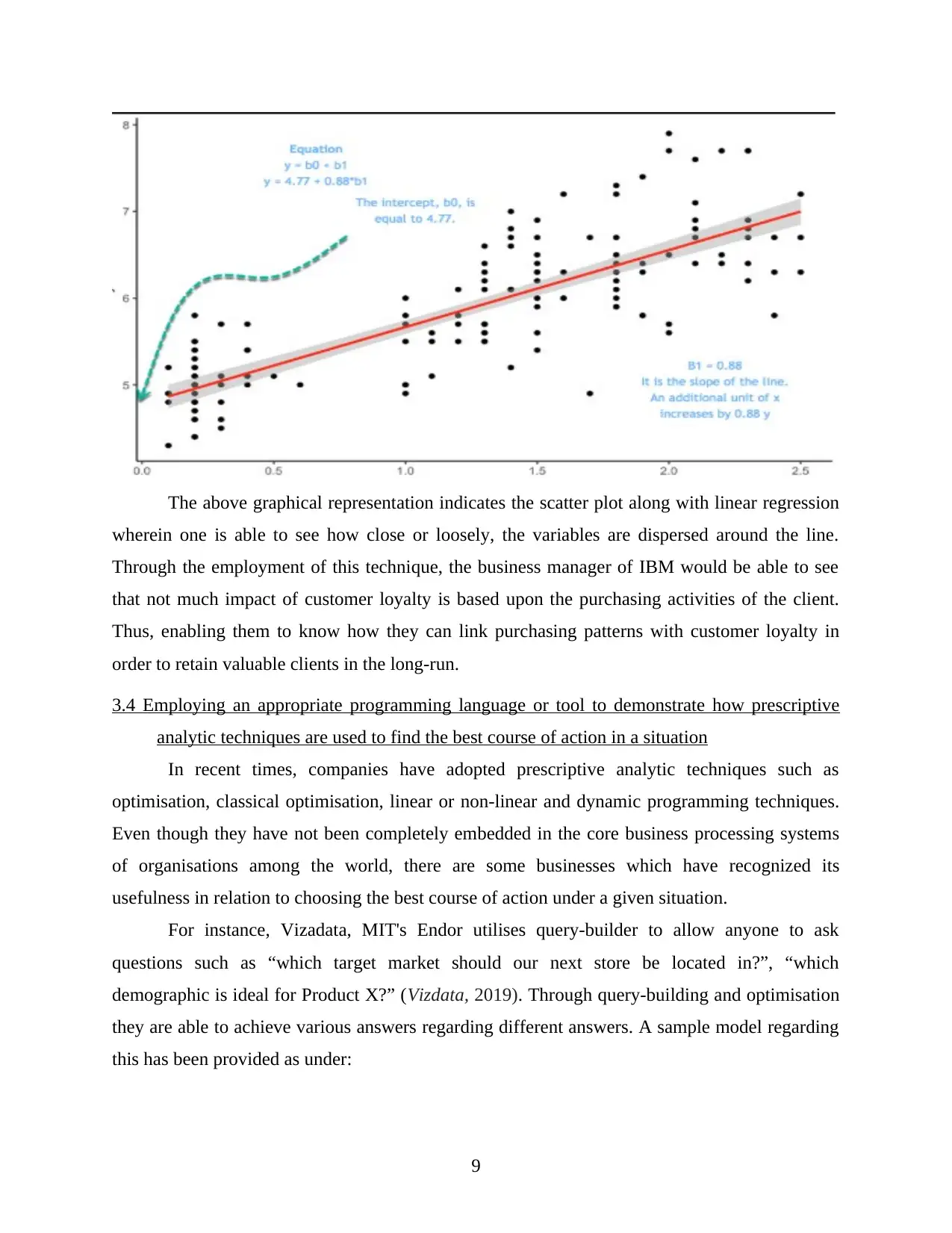
The above graphical representation indicates the scatter plot along with linear regression
wherein one is able to see how close or loosely, the variables are dispersed around the line.
Through the employment of this technique, the business manager of IBM would be able to see
that not much impact of customer loyalty is based upon the purchasing activities of the client.
Thus, enabling them to know how they can link purchasing patterns with customer loyalty in
order to retain valuable clients in the long-run.
3.4 Employing an appropriate programming language or tool to demonstrate how prescriptive
analytic techniques are used to find the best course of action in a situation
In recent times, companies have adopted prescriptive analytic techniques such as
optimisation, classical optimisation, linear or non-linear and dynamic programming techniques.
Even though they have not been completely embedded in the core business processing systems
of organisations among the world, there are some businesses which have recognized its
usefulness in relation to choosing the best course of action under a given situation.
For instance, Vizadata, MIT's Endor utilises query-builder to allow anyone to ask
questions such as “which target market should our next store be located in?”, “which
demographic is ideal for Product X?” (Vizdata, 2019). Through query-building and optimisation
they are able to achieve various answers regarding different answers. A sample model regarding
this has been provided as under:
9
wherein one is able to see how close or loosely, the variables are dispersed around the line.
Through the employment of this technique, the business manager of IBM would be able to see
that not much impact of customer loyalty is based upon the purchasing activities of the client.
Thus, enabling them to know how they can link purchasing patterns with customer loyalty in
order to retain valuable clients in the long-run.
3.4 Employing an appropriate programming language or tool to demonstrate how prescriptive
analytic techniques are used to find the best course of action in a situation
In recent times, companies have adopted prescriptive analytic techniques such as
optimisation, classical optimisation, linear or non-linear and dynamic programming techniques.
Even though they have not been completely embedded in the core business processing systems
of organisations among the world, there are some businesses which have recognized its
usefulness in relation to choosing the best course of action under a given situation.
For instance, Vizadata, MIT's Endor utilises query-builder to allow anyone to ask
questions such as “which target market should our next store be located in?”, “which
demographic is ideal for Product X?” (Vizdata, 2019). Through query-building and optimisation
they are able to achieve various answers regarding different answers. A sample model regarding
this has been provided as under:
9

The above graph indicates how Vizdata has implemented Predictive Analysis technique
so as to ascertain what size of store must be opened along with the fact that whether or not Store
Layout must be given much emphasis or not.
CONCLUSION
From the above report it can be concluded that Data Analytics has become a critical part
of organisations worldwide. Without it, they face various problems such as delayed decision as
well as execution of such plans of actions on the part of the management. It is also important to
note that various analytical techniques and programming languages such as Descriptive,
Predictive as well as Prescriptive enable the users of data to take actions, forecast outcomes and
ascertain various steps to choose from. In addition to this, data visualisation is also critical so as
to communicate the information or output derived through the implementation of various
analytical models in an effective manner.
10
so as to ascertain what size of store must be opened along with the fact that whether or not Store
Layout must be given much emphasis or not.
CONCLUSION
From the above report it can be concluded that Data Analytics has become a critical part
of organisations worldwide. Without it, they face various problems such as delayed decision as
well as execution of such plans of actions on the part of the management. It is also important to
note that various analytical techniques and programming languages such as Descriptive,
Predictive as well as Prescriptive enable the users of data to take actions, forecast outcomes and
ascertain various steps to choose from. In addition to this, data visualisation is also critical so as
to communicate the information or output derived through the implementation of various
analytical models in an effective manner.
10
⊘ This is a preview!⊘
Do you want full access?
Subscribe today to unlock all pages.

Trusted by 1+ million students worldwide
1 out of 13
Related Documents
Your All-in-One AI-Powered Toolkit for Academic Success.
+13062052269
info@desklib.com
Available 24*7 on WhatsApp / Email
![[object Object]](/_next/static/media/star-bottom.7253800d.svg)
Unlock your academic potential
Copyright © 2020–2025 A2Z Services. All Rights Reserved. Developed and managed by ZUCOL.





